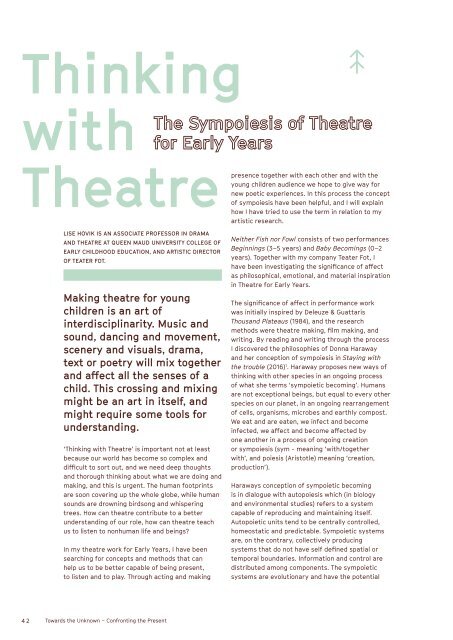ASSITEJ Magazine 2019
This is the annual ASSITEJ magazine, launched during the ASSITEJ Artistic Gathering 2019 in Kristiansand (Norway). It contains high-quality articles on theatre for young audiences from all corners of the world!
This is the annual ASSITEJ magazine, launched during the ASSITEJ Artistic Gathering 2019 in Kristiansand (Norway). It contains high-quality articles on theatre for young audiences from all corners of the world!
You also want an ePaper? Increase the reach of your titles
YUMPU automatically turns print PDFs into web optimized ePapers that Google loves.
Thinking<br />
with<br />
Theatre<br />
LISE HOVIK IS AN ASSOCIATE PROFESSOR IN DRAMA<br />
AND THEATRE AT QUEEN MAUD UNIVERSITY COLLEGE OF<br />
EARLY CHILDHOOD EDUCATION, AND ARTISTIC DIRECTOR<br />
OF TEATER FOT.<br />
Making theatre for young<br />
children is an art of<br />
interdisciplinarity. Music and<br />
sound, dancing and movement,<br />
scenery and visuals, drama,<br />
text or poetry will mix together<br />
and affect all the senses of a<br />
child. This crossing and mixing<br />
might be an art in itself, and<br />
might require some tools for<br />
understanding.<br />
‘Thinking with Theatre’ is important not at least<br />
because our world has become so complex and<br />
difficult to sort out, and we need deep thoughts<br />
and thorough thinking about what we are doing and<br />
making, and this is urgent. The human footprints<br />
are soon covering up the whole globe, while human<br />
sounds are drowning birdsong and whispering<br />
trees. How can theatre contribute to a better<br />
understanding of our role, how can theatre teach<br />
us to listen to nonhuman life and beings?<br />
In my theatre work for Early Years, I have been<br />
searching for concepts and methods that can<br />
help us to be better capable of being present,<br />
to listen and to play. Through acting and making<br />
presence together with each other and with the<br />
young children audience we hope to give way for<br />
new poetic experiences. In this process the concept<br />
of sympoiesis have been helpful, and I will explain<br />
how I have tried to use the term in relation to my<br />
artistic research.<br />
Neither Fish nor Fowl consists of two performances<br />
Beginnings (3–5 years) and Baby Becomings (0–2<br />
years). Together with my company Teater Fot, I<br />
have been investigating the significance of affect<br />
as philosophical, emotional, and material inspiration<br />
in Theatre for Early Years.<br />
The significance of affect in performance work<br />
was initially inspired by Deleuze & Guattaris<br />
Thousand Plateaus (1984), and the research<br />
methods were theatre making, film making, and<br />
writing. By reading and writing through the process<br />
I discovered the philosophies of Donna Haraway<br />
and her conception of sympoiesis in Staying with<br />
the trouble (2016) 1 . Haraway proposes new ways of<br />
thinking with other species in an ongoing process<br />
of what she terms ‘sympoietic becoming’. Humans<br />
are not exceptional beings, but equal to every other<br />
species on our planet, in an ongoing rearrangement<br />
of cells, organisms, microbes and earthly compost.<br />
We eat and are eaten, we infect and become<br />
infected, we affect and become affected by<br />
one another in a process of ongoing creation<br />
or sympoiesis (sym - meaning ‘with/together<br />
with’, and poiesis (Aristotle) meaning ‘creation,<br />
production’).<br />
Haraways conception of sympoietic becoming<br />
is in dialogue with autopoiesis which (in biology<br />
and environmental studies) refers to a system<br />
capable of reproducing and maintaining itself.<br />
Autopoietic units tend to be centrally controlled,<br />
homeostatic and predictable. Sympoietic systems<br />
are, on the contrary, collectively producing<br />
systems that do not have self defined spatial or<br />
temporal boundaries. Information and control are<br />
distributed among components. The sympoietic<br />
systems are evolutionary and have the potential<br />
42 Towards the Unknown – Confronting the Present



